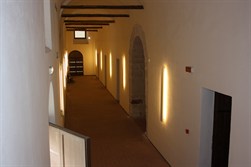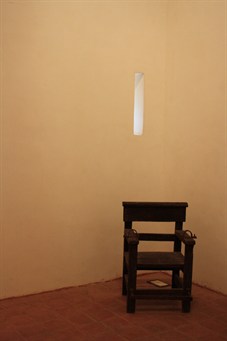The prison of the Penitenziati
 After listening to the sentence, the accused was then brought in a new palace, built at the beginning of the seventeenth century, which is located at the rear of the complex of the Steri Palace, where in medieval times there were the kilns used to produce ceramic tableware and glasses. It is the prison of the Penitenziati (photo 1), where we can still admire a moving trace of the prisoners by which we can know their names and then, studying the documents of the trials that are now in the National Archives of Madrid, we can reconstruct their stories. These rooms have been forgotten after the closure of the Tribunal. Probably the viceroy Caracciolo, in addition to destroying the records of the Holy Office in Palermo and the instruments of torture, ordered to paint the rooms. Subsequently, the different uses of those spaces helped to erase even the memory of the purposes for which they were intended for a long time: above all, the opening of windows capable of lighting the rooms changed the original situation of rooms of about thirty-forty square meters, lit only by a slit at the top of the wall (photo 2). The prisons became so unrecognizable and for a long time they were the seat of the royal prosecutor’s office of Palermo.
After listening to the sentence, the accused was then brought in a new palace, built at the beginning of the seventeenth century, which is located at the rear of the complex of the Steri Palace, where in medieval times there were the kilns used to produce ceramic tableware and glasses. It is the prison of the Penitenziati (photo 1), where we can still admire a moving trace of the prisoners by which we can know their names and then, studying the documents of the trials that are now in the National Archives of Madrid, we can reconstruct their stories. These rooms have been forgotten after the closure of the Tribunal. Probably the viceroy Caracciolo, in addition to destroying the records of the Holy Office in Palermo and the instruments of torture, ordered to paint the rooms. Subsequently, the different uses of those spaces helped to erase even the memory of the purposes for which they were intended for a long time: above all, the opening of windows capable of lighting the rooms changed the original situation of rooms of about thirty-forty square meters, lit only by a slit at the top of the wall (photo 2). The prisons became so unrecognizable and for a long time they were the seat of the royal prosecutor’s office of Palermo.
 Only in the early twentieth century, during another renovation work, the historian born in Palermo Giuseppe Pitrè made a first visit to the palace after the chance discovery of a design that was visible in transparency under the plaster that was crumbling, thus discovering the first tragic testimonies of the life led in those rooms. Pitrè called these graphic documents with the expression “palimpsests of the prison” and began to decipher the writings. However, after the discovery there was not a revaluation of these spaces and they were again forgotten. They were rediscovered in the sixties, but once again it was not possible to protect them because, while the American soldiers occupied Palermo during the Second World War, a strange figure, don Totò, had settled at the Steri Palace, asserting that the complex belonged to him and using it as a car wrecker warehouse. In fact, for a long time the building and the surrounding structures had been properties of the University, which took again control of them after the death of don Totò. And it is only recently that these rooms are visible to the public and we can see testimonies which are unique in the world.
Only in the early twentieth century, during another renovation work, the historian born in Palermo Giuseppe Pitrè made a first visit to the palace after the chance discovery of a design that was visible in transparency under the plaster that was crumbling, thus discovering the first tragic testimonies of the life led in those rooms. Pitrè called these graphic documents with the expression “palimpsests of the prison” and began to decipher the writings. However, after the discovery there was not a revaluation of these spaces and they were again forgotten. They were rediscovered in the sixties, but once again it was not possible to protect them because, while the American soldiers occupied Palermo during the Second World War, a strange figure, don Totò, had settled at the Steri Palace, asserting that the complex belonged to him and using it as a car wrecker warehouse. In fact, for a long time the building and the surrounding structures had been properties of the University, which took again control of them after the death of don Totò. And it is only recently that these rooms are visible to the public and we can see testimonies which are unique in the world.
